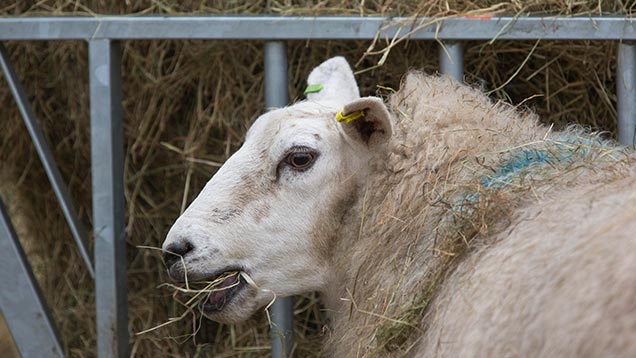‘Complete rethink’ needed on pregnant ewe nutrition
 © Tim Scrivener
© Tim Scrivener Making high-quality silage and feeding it to ewes in late pregnancy will not only save on feed costs, but will also establish a grazing system to optimise lamb growth rates.
That is the advice from senior sheep consultant John Vipond of Scotland’s Rural University College, who said all that is needed is one big bale of silage for every four ewes.
See also: Latest sheep industry news
“Feeding silage with an ME of more than 11 means a huge amount of money can be saved on bought-in feed. And there is even more savings to be made in the time and labour involved in feeding in-lamb ewes,” he said.
Dr Vipond urged sheep produces to exploit 11 ME silage that would provide enough energy to meet a ewe’s total feed requirements, provided she was in reasonable condition and even if she was carrying triplets.
“It only costs about £3/ha more to make top-quality silage. We underestimate the potential feed value of big-baled silage.”
John Vipond, Scotland’s Rural University College
“It only costs about £3/ha more to make top-quality silage. We underestimate the potential feed value of big-baled silage, but with modern equipment, taking extra care in making the silage and using accurate weather forecasting, sheep producers can make a valuable feed source that can save on bought-in feed costs.”
Dr Vipond was advocating a complete rethink on how pregnant ewes were fed by focusing on supplying protein only through soya.
“To get more protein into ewes, soya can be fed at 100g a head a day for every lamb being carried, although our trials using protected soya have shown we can reduce that feed rate to just 50g per lamb carried.
“We recommend feeding for 30 days, which means total intake can be as low as 3kg of feed per ewe, fed with mineralised silage. For twin-bearing ewes that is a feed cost of £1.50-£2 a ewe compared with £5-£6.”
Dr Vipond recognised this feed regime was a break with many traditional in-lamb ewe diets.
However, he said a farmer who was applying his recommendations and had scrapped feeding his triplet-bearing ewes 700g of blend for the past two weeks of pregnancy had noticed a big imrpovemnet in lamb viability.
“Although he did feed from six weeks pre-lambing – he noticed his lambs were more vigorous at birth and that ewes had better-quality colostrum and there was more of it.”

